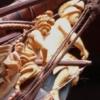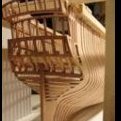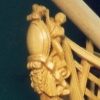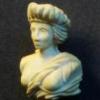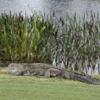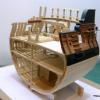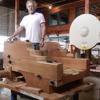MORE HANDBOOKS ARE ON THEIR WAY! We will let you know when they get here.
×
-
Posts
1,307 -
Joined
-
Last visited
Reputation Activity
-
 Gaetan Bordeleau got a reaction from qwerty2008 in Le Fleuron by Gaetan Bordeleau - FINISHED - 1:24
Gaetan Bordeleau got a reaction from qwerty2008 in Le Fleuron by Gaetan Bordeleau - FINISHED - 1:24
The last method for centering a square part is quite precise.
If you put it in a lathe collet it will be even more precise.
This is how it is made in jewelry.
Jewelers can teach us a lot of technics.
-
 Gaetan Bordeleau got a reaction from JerryGreening in Le Fleuron by Gaetan Bordeleau - FINISHED - 1:24
Gaetan Bordeleau got a reaction from JerryGreening in Le Fleuron by Gaetan Bordeleau - FINISHED - 1:24
Continuation + some jigs for repetitive operations.
-
 Gaetan Bordeleau got a reaction from Jeronimo in Le Fleuron by Gaetan Bordeleau - FINISHED - 1:24
Gaetan Bordeleau got a reaction from Jeronimo in Le Fleuron by Gaetan Bordeleau - FINISHED - 1:24
The last method for centering a square part is quite precise.
If you put it in a lathe collet it will be even more precise.
This is how it is made in jewelry.
Jewelers can teach us a lot of technics.
-
 Gaetan Bordeleau got a reaction from druxey in Le Fleuron by Gaetan Bordeleau - FINISHED - 1:24
Gaetan Bordeleau got a reaction from druxey in Le Fleuron by Gaetan Bordeleau - FINISHED - 1:24
The last method for centering a square part is quite precise.
If you put it in a lathe collet it will be even more precise.
This is how it is made in jewelry.
Jewelers can teach us a lot of technics.
-
 Gaetan Bordeleau got a reaction from JerryGreening in Le Fleuron by Gaetan Bordeleau - FINISHED - 1:24
Gaetan Bordeleau got a reaction from JerryGreening in Le Fleuron by Gaetan Bordeleau - FINISHED - 1:24
To turn the axle for a square, there is no need to use the 4 jaw chuck.
You just need to insert the square axle in a brass tubing. To be able to apply pressure without deforming the brass tubing, 2 cuts in line are enough.
-
 Gaetan Bordeleau got a reaction from EdT in Le Fleuron by Gaetan Bordeleau - FINISHED - 1:24
Gaetan Bordeleau got a reaction from EdT in Le Fleuron by Gaetan Bordeleau - FINISHED - 1:24
Continuation + some jigs for repetitive operations.
-
 Gaetan Bordeleau got a reaction from qwerty2008 in Le Fleuron by Gaetan Bordeleau - FINISHED - 1:24
Gaetan Bordeleau got a reaction from qwerty2008 in Le Fleuron by Gaetan Bordeleau - FINISHED - 1:24
To turn the axle for a square, there is no need to use the 4 jaw chuck.
You just need to insert the square axle in a brass tubing. To be able to apply pressure without deforming the brass tubing, 2 cuts in line are enough.
-
 Gaetan Bordeleau got a reaction from archjofo in Le Fleuron by Gaetan Bordeleau - FINISHED - 1:24
Gaetan Bordeleau got a reaction from archjofo in Le Fleuron by Gaetan Bordeleau - FINISHED - 1:24
To turn the axle for a square, there is no need to use the 4 jaw chuck.
You just need to insert the square axle in a brass tubing. To be able to apply pressure without deforming the brass tubing, 2 cuts in line are enough.
-
 Gaetan Bordeleau got a reaction from archjofo in Le Fleuron by Gaetan Bordeleau - FINISHED - 1:24
Gaetan Bordeleau got a reaction from archjofo in Le Fleuron by Gaetan Bordeleau - FINISHED - 1:24
The last method for centering a square part is quite precise.
If you put it in a lathe collet it will be even more precise.
This is how it is made in jewelry.
Jewelers can teach us a lot of technics.
-
 Gaetan Bordeleau got a reaction from cog in Le Fleuron by Gaetan Bordeleau - FINISHED - 1:24
Gaetan Bordeleau got a reaction from cog in Le Fleuron by Gaetan Bordeleau - FINISHED - 1:24
Continuation + some jigs for repetitive operations.
-
 Gaetan Bordeleau got a reaction from allanyed in Le Fleuron by Gaetan Bordeleau - FINISHED - 1:24
Gaetan Bordeleau got a reaction from allanyed in Le Fleuron by Gaetan Bordeleau - FINISHED - 1:24
To turn the axle for a square, there is no need to use the 4 jaw chuck.
You just need to insert the square axle in a brass tubing. To be able to apply pressure without deforming the brass tubing, 2 cuts in line are enough.
-
 Gaetan Bordeleau got a reaction from qwerty2008 in Le Fleuron by Gaetan Bordeleau - FINISHED - 1:24
Gaetan Bordeleau got a reaction from qwerty2008 in Le Fleuron by Gaetan Bordeleau - FINISHED - 1:24
Continuation + some jigs for repetitive operations.
-
 Gaetan Bordeleau got a reaction from Jeronimo in Le Fleuron by Gaetan Bordeleau - FINISHED - 1:24
Gaetan Bordeleau got a reaction from Jeronimo in Le Fleuron by Gaetan Bordeleau - FINISHED - 1:24
To turn the axle for a square, there is no need to use the 4 jaw chuck.
You just need to insert the square axle in a brass tubing. To be able to apply pressure without deforming the brass tubing, 2 cuts in line are enough.
-
 Gaetan Bordeleau got a reaction from archjofo in Le Fleuron by Gaetan Bordeleau - FINISHED - 1:24
Gaetan Bordeleau got a reaction from archjofo in Le Fleuron by Gaetan Bordeleau - FINISHED - 1:24
Continuation + some jigs for repetitive operations.
-
 Gaetan Bordeleau got a reaction from tlevine in Le Fleuron by Gaetan Bordeleau - FINISHED - 1:24
Gaetan Bordeleau got a reaction from tlevine in Le Fleuron by Gaetan Bordeleau - FINISHED - 1:24
To turn the axle for a square, there is no need to use the 4 jaw chuck.
You just need to insert the square axle in a brass tubing. To be able to apply pressure without deforming the brass tubing, 2 cuts in line are enough.
-
 Gaetan Bordeleau got a reaction from paulsutcliffe in Le Fleuron by Gaetan Bordeleau - FINISHED - 1:24
Gaetan Bordeleau got a reaction from paulsutcliffe in Le Fleuron by Gaetan Bordeleau - FINISHED - 1:24
COMPLETING 2D PARTS
Progression continues, 2D portion is now completed. I tried to do it in 1 block. This way it is easier to have the same style in the carvings. To give a bigger volume to the 2D parts, many were cut in a thicker plank than require (especially the flowers) in a way, trying to make it look bit more 3D than it is really.
Some parts were directly made from the plans, other were made according the place on the exact place where i twill be install on the model. This way the parts fits before to be carved.
Remaining sculptures are 3D noted in red on the original drawings. On the first picture.
On the second picture, 4 pictures regrouped to give an idea of the progression of the construction; which is similar in many ways to a house : framing, walls, moldings and decoration on the other pics.
The third pic is to show how to work standing having every thing at the good height.
-
 Gaetan Bordeleau got a reaction from Maury S in Le Fleuron by Gaetan Bordeleau - FINISHED - 1:24
Gaetan Bordeleau got a reaction from Maury S in Le Fleuron by Gaetan Bordeleau - FINISHED - 1:24
To turn the axle for a square, there is no need to use the 4 jaw chuck.
You just need to insert the square axle in a brass tubing. To be able to apply pressure without deforming the brass tubing, 2 cuts in line are enough.
-
 Gaetan Bordeleau got a reaction from egen in Le Fleuron by Gaetan Bordeleau - FINISHED - 1:24
Gaetan Bordeleau got a reaction from egen in Le Fleuron by Gaetan Bordeleau - FINISHED - 1:24
Continuation + some jigs for repetitive operations.
-
 Gaetan Bordeleau got a reaction from ggrieco in Le Fleuron by Gaetan Bordeleau - FINISHED - 1:24
Gaetan Bordeleau got a reaction from ggrieco in Le Fleuron by Gaetan Bordeleau - FINISHED - 1:24
Here are the pictures I would have enter in a 2015 Contest ; but I forgot to enter.
I took what they considered weak points in the 2013 Contest and turned it in strong points:
CONSTRUCTION D’UN MODÈLE D’UN VAISSEAU DE 74 CANONS FRANÇAIS À BREST EN 1780 POUR L’INSTRUCTION DES GARDES DE LA MARINE SELON LES ORDONNANCES NAVALES
You will enter in an Innotive approach for the construction of this 1/24 scale model, 8 feet long. This bigger scale made possible the discovery of new opportunities and provided another layer in Hull construction techniques. Here are some words of wisdom from the Great Master Builder SJSoane : « All details should be considered in light of the overall artistic effect of the model as a whole. Building the details helped me understand how these ships were made, and how the parts functioned » Underline part is similar in essence to what Jean Boudriot said about when determining the shape of the rail that in a sense the shape had no specific shape but it must perfectly blend with the whole model when making the main, middle and lower rail.
New scale means new problems : How to bend ½’’ of ebony? You must cut it from blocks. The model weighs 125 pounds. How do you adjust the working height of the model? Quite easily in fact, with an electric modified dental chair.
Bigger scale means larger wood grain. Cherry wood is a good example at 1/24 scale. When carefully selected, nice wood grain patterns appears. Woods for this build are also chosen for their color. The rarest wood used is Bocote. Other than his distinctive nutty odor when cutting it, this wood quickly darkens in presence of air. On the model, outside planking above the wales shows this wood as if it has been aged for 100 years. No paint is use, only Tung oil, a finer oil than linen seed, clearer with no deposit. Whenever greater aged look is required, natural Bitumen in powder is added.
This work was inspired by ‘’Naval Ordonnances’’ for Marine Guards in Brest, France. It is intended to be built as an instructionnal model, which could be use by Naval officers to teach the aspiring officers. Instructions were grouped in 2 categories : Masting and Rigging, the standard methods according the ship size and category. For this build, the other category was deeply explored : Hull construction is unique for each ship according to his own decorations and sculptures. Big cares are taken to build the inside and it would be a shame not to show it. Decks are left open as much as possible to facilitate inside looks.
Port side is left open to show the double framing structure. Cannons are installed on 1 side only, so that construction methods can be emphasies the other side. Oversized recoil pulleys, standard french navy procedure, increasing the diameter to reduce the number of men required.
-
 Gaetan Bordeleau got a reaction from ggrieco in Le Fleuron by Gaetan Bordeleau - FINISHED - 1:24
Gaetan Bordeleau got a reaction from ggrieco in Le Fleuron by Gaetan Bordeleau - FINISHED - 1:24
Further comment to Druxey's stairs observation and Ed's.
I was measuring the lenght of the rope which will be use to pull the anchor cable out of the water. On the 74 guns, this rope was passing above the stair and it was surely a potentially situation. On Le Fleuron that rope passes below the stair and has a lot of place.
Walking stair usually have constant height between each one. In this situation it is like a stair made in 2 parts, one first descent, one stair plate and one final descent; the same principle when a stair gets down turn and get down for the final steps.
-
 Gaetan Bordeleau got a reaction from ggrieco in Le Fleuron by Gaetan Bordeleau - FINISHED - 1:24
Gaetan Bordeleau got a reaction from ggrieco in Le Fleuron by Gaetan Bordeleau - FINISHED - 1:24
Turning guns
Le Fleuron had some guns with decorations on it. Also, we could have seen some 24 pounds but for some unknown reasons, this ship was poorly dress with low caliber guns. Considering that I prefer a more homogeneous look and also that I already a brass supply of round bars, I will only fabricate standard guns and for 1 side only: 12 x 18 pounds, 13 x 12 pounds and 5 x 8 pounds for 30 canons. This would have meant 60 guns plus 4 openings in the aft section from the first deck; 60 guns 64 openings.
The key to turn the guns is to progress by set up and do identical operation for each gun. It would be unthinkable to turn 1 gun at the time and to repeat all the setup 30 times.
Half inch collet will hold each blank. The use of collet is much more precise than a 3 jaw chuck. After cutting the blanks, a shoulder of half inch is done at 1 end and a pilot hole is drilled at the other end for each blanks.
Next, a taper attachment is use to turn the required taper angle. The cross section leading screw is remove and the positionning is done by a guide following an angle. The easy way to set up the taper adjustment angle is to turn a taper blank and adjust the difference of diameter for a given distance, the adjustment can be done in 4 or 5 light passes .
The tapered portion of the gun is in the middle section. Head and bottom are kept for later and do not require the taper attachment to be turned. For the middle section, 3 shoulders are turned. The rest of the turning will be done without the taper attachment.
Brass is very different from steel to turn. Instead of long swirl, thousounds of small shine flies everywhere and also on the floor. The faster the turning speed, the farther the particles fly.
Cleaning is longer to do than turning. It is important to keep the taper adjustment angle clean in all time to have a smooth operation. The only way to do so is to place a cloth over it to keep it free from particles.
-
 Gaetan Bordeleau got a reaction from paulsutcliffe in Le Fleuron by Gaetan Bordeleau - FINISHED - 1:24
Gaetan Bordeleau got a reaction from paulsutcliffe in Le Fleuron by Gaetan Bordeleau - FINISHED - 1:24
Before I bought stdio flash, I did a lamp with 2 adjustable LED spots. I took it out of the closet and installed it over the working table. You can see on the table top how it illuminates. The last picture is done with these 2 spots.
I also did a table for the next exposition. I tried a new receipe for fast dying and waxiing wood :
Drop Bee wax shavings in a pot cover with odorless turpentine This will make the wax liquid and it will be very easy to apply the wax, and the turpentine will then avporate in the air.
To intensify the color and also to give a greater aged look, add bitumen and mix. Again turpentine will do the same action as it did to the beewax.
For a final ingredient, double the quantity already mixed with tung oil which is also going to help the look of the wood grain m making iti look richer.
-
 Gaetan Bordeleau got a reaction from harvey1847 in Le Fleuron by Gaetan Bordeleau - FINISHED - 1:24
Gaetan Bordeleau got a reaction from harvey1847 in Le Fleuron by Gaetan Bordeleau - FINISHED - 1:24
Continuation + some jigs for repetitive operations.
-
 Gaetan Bordeleau got a reaction from archjofo in Le Fleuron by Gaetan Bordeleau - FINISHED - 1:24
Gaetan Bordeleau got a reaction from archjofo in Le Fleuron by Gaetan Bordeleau - FINISHED - 1:24
% of composition is probably the answer. If I would have to give it a name, I think this is probably free machining brass!
The longest part to turn guns is done.
4 knives are use for the top and bottom turning.
Lenght references are done by a reference wood plate, it is mucg faster this way.
The head is done first and then the inside is drilled. This operation is done as late as possible so that the opening dos not enlarge because of the live center.
The bottom part is kept for the last part.
-
 Gaetan Bordeleau got a reaction from tadheus in Le Fleuron by Gaetan Bordeleau - FINISHED - 1:24
Gaetan Bordeleau got a reaction from tadheus in Le Fleuron by Gaetan Bordeleau - FINISHED - 1:24
To turn the axle for a square, there is no need to use the 4 jaw chuck.
You just need to insert the square axle in a brass tubing. To be able to apply pressure without deforming the brass tubing, 2 cuts in line are enough.


